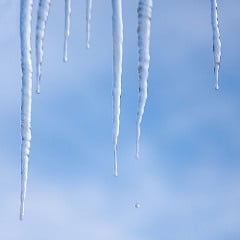Protect Your Building by Preventing Ice Dams this Winter

The wintertime dangers of cold temperatures, snow, and ice are well known, but there is another seasonal problem that can put both residential and commercial buildings at risk. Ice dams can cause damage to building roofs and lead to water leaks that can ruin insulation, damage flooring and wall coverings, and destroy paper records, books, vital documents and other important equipment.
What are Ice Dams?
Ice dams are accumulations of ice that form at the edges of a building’s roof. Ice dams hold back water and prevent it from draining into your gutters or off the roof. The water from rainfall or melting snow and ice accumulates behind these ice dams until it overflows. When this happens, the water often leaks through your roof and into your building. Water can make its way inside your walls, where it can soak insulation and make it useless. The water can leak through the ceilings and into the rooms inside your building, causing damage to electronic equipment, merchandise, records, and other important material. It can damage wallpaper and other wall coverings, soak carpets, and even cause structural damage.
What Causes Ice Dams?
Ice dams form when higher sections of your roof are warmer than the edges of the roof and sections lower down. On the warmer sections, snow and ice melt more easily, producing water that runs down toward the gutters and the edge of the roof. Normally, that water would be drained away, but if the edges of the roof are cold enough, the water will refreeze and start to accumulate. In a relatively short amount of time, enough water can turn to ice at the edge of your roof to create an effective container for other rain or water that comes after it. The ice dam holds this water in place until the inevitable overflow occurs.
Another aspect of ice dams is the weight of the ice as it accumulates. It is not uncommon for ice dams to also have huge icicles on them. While these ice formations can look spectacular, their weight can cause damage to your roof, potentially opening up holes or gaps that can cause more severe water leaks. Accumulated ice can damage shingles, guttering, and even the underlying framework of your roof if it gets heavy enough.
Finally, an ice dam with attached icicles can be a potential physical danger for anyone walking underneath the ice if and when it breaks off and falls.
How to Prevent Ice Dams
Ice dams can be prevented with a few simple techniques.
- Clean your roof: After a snowfall or ice storm, clean your roof as soon as possible. Use a broom to sweep away the snow before it has a chance to melt. Clearing large accumulations of ice after a storm may be more difficult and could require professional assistance. The goal is to ensure that there is as little snow and ice as possible on your roof, removing the likelihood that snowmelt will turn into ice dams.
- Increase roof insulation: Insulation helps prevent heat flow from the inside of your building to the outside, so more insulation will stop warm spots from developing on your roof. A layer of insulation will keep your roof at a consistent temperature that stops freezing at the edges of the roof.
- Find and seal roof air leaks: Any air leaks in your roof will allow warm indoor air to escape. This not only wastes energy and increases your monthly heating bills, it also creates warm spots where snow and ice can melt. Find and seal any air leaks in the roof with caulking. Repair or replace damaged shingles or roofing material.
Our goal is to help educate our customers about Plumbing, HVACR, Fire Protection, and Alarm Systems in Mechanical, Commercial, and Residential settings. For more information on preventing ice dams, and to view projects we’ve worked on, visit our website!
Photo Credit: Arjan Almekinders via Compfight cc







